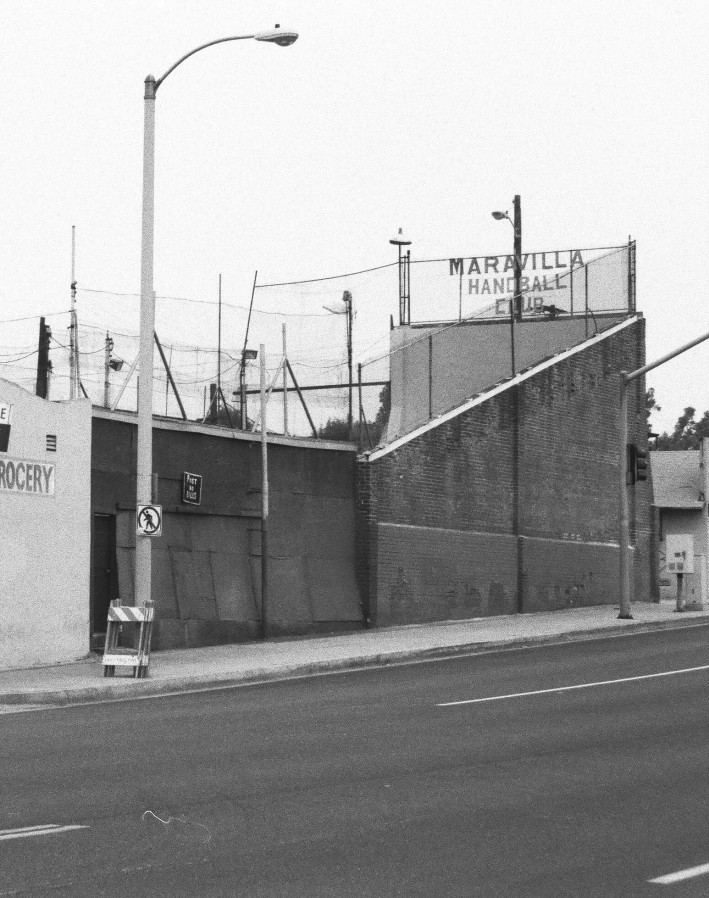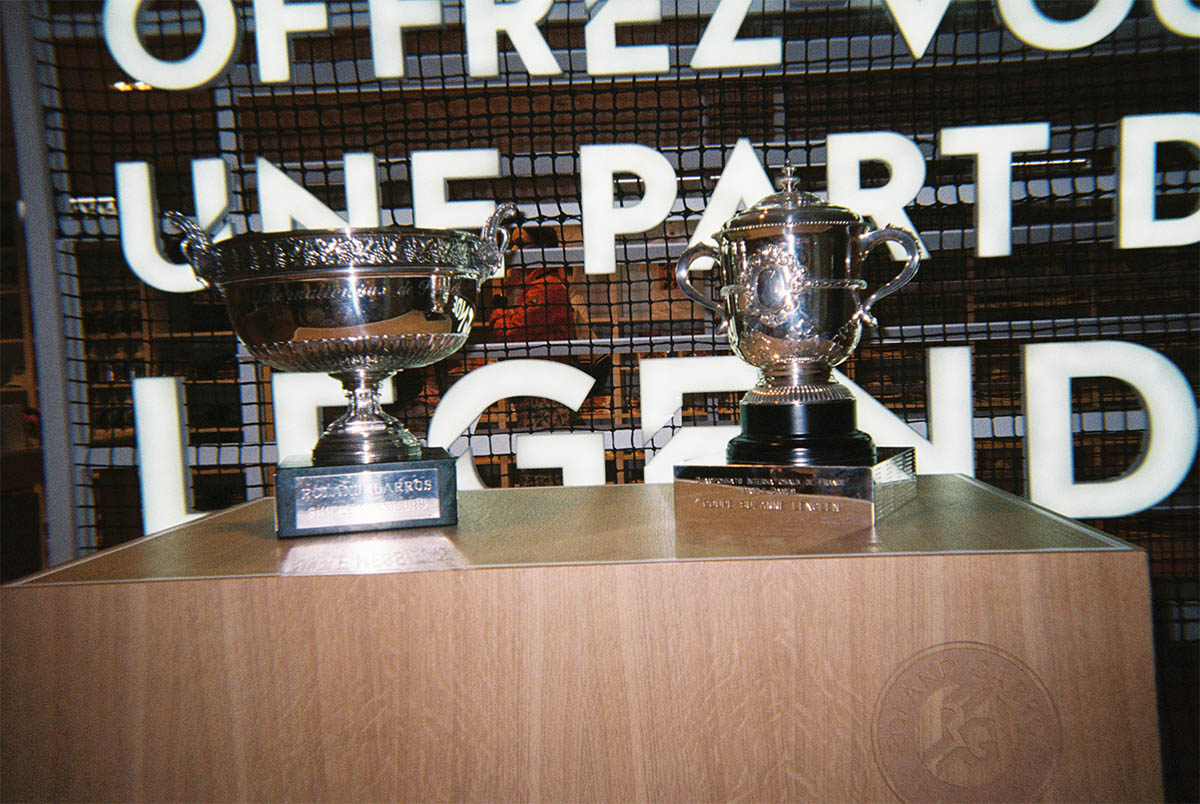Photo by Ronnie Castro


In November 1923, the Owensmouth Chamber of Commerce brought a matter before the Los Angeles City Council regarding a handball court owned by one Sixto M. Salcido. A small community in the northwest corner of the San Fernando Valley, Owensmouth was built around a Southern Pacific railroad stop in what is now Canoga Park. The Chamber of Commerce petitioned the council to permanently revoke Salcido’s business license, claiming the court had become a “serious nuisance due to drunkenness and fighting among the men who hang around it.”
When an L.A. Times reporter contacted him for comment, Salcido was perplexed by talk of trouble. The reporter wrote: “It is true that a month ago two marijuaneros1 came in and one of them shot at him—but they got the marijuana outside. And sometimes some rowdy countrymen filled with bootleg came in to jeer at the players.” Salcido showed the reporter his court and asked if anything looked untoward. “These men work on the railroad and building a new city over the hill, called El Girardo,” Salcido told the reporter. “They work all week and come here Sundays to play ball.”
- Marijuanero Someone who sells or traffics marijuana
A week later, the City Council received a petition from more than 50 Mexican residents of Owensmouth. They had read the article and wanted to testify to the “character and peaceful disposition of Senor Salcedo [sic] and to the good that is said to have resulted from the handball court.” Before Salcido opened the court, they said, locals would congregate in secret places and play card games and other pastimes “greatly endangering the safety and peace of the community,” but the handball court had “cured these evil conditions.”
There’s no further record of the court’s fate. Owensmouth was renamed Canoga Park in 1931. Salcido died in the 1950s. A 1930 city directory lists his occupation as grocer and shows him living on the corner of Hart Street and Canoga Avenue. Today, there’s nothing on that corner but a tire shop and the newly paved parking lot for an animal hospital called the Canoga Pet Resort.
For European handball historians, the sport’s motherland has always been Ireland, where the countryside is dotted with aging stone “alleys,” long since abandoned and hidden beneath moss. They typically trace the birth of handball in the United States to Phil Casey, an immigrant from County Laois, who built the first American alley on the corner of Douglass and Hoyt, in Brooklyn’s Boerum Hill. In an 1894 interview, Casey said handball originated with the Romans, who played it “20 years before the time of Christ.” The game’s roots extend to Egypt, where the tombs of Osiris in Thebes are inscribed with images of men striking a ball with their hands. From Egypt, it went to Greece via Alexander the Great, who then spread it to the Greek colonies in Italy. From there, Catholic missionaries took it to Spain, France, and Ireland, where in 1527 church authorities in Galway issued an edict banning “the playing of ball games against the walls of the town.”
The historians who trace this lineage are unaware or uninterested in the fact that there were images of handball being played in Mexico as far back as 3000 BC. The game has connections to the Nahua of central Mexico; the Zapotec of Oaxaca; the Mixtec of Guerrero; the Tarasca of Michoacan.
- Varrio Neighborhood. “Varrio” is the spelling that is specific to the Chicano culture of Los Angeles. To the author, it carries a Southwestern MexicanAmerican connotation that is very distinct from, say, the Puerto Rican “barrio” of Harlem.
In the unincorporated rural land east of the Los Angeles County line, a new varrio2 spread outward below the Davidson Brick Company. Each day, the plant’s gas-fired kilns produced 320,000 bricks, molded from red shale that crews of Mexican laborers extracted from a gaping quarry above Ford Boulevard and Floral Drive. East of Mednik Avenue, the neighborhood turned to open fields where Japanese women in bonnets tended to beds of sugar beets, cabbage, and chrysanthemums. In hopes of attracting upwardly mobile Anglos, real estate opportunists branded the area “Belvedere Gardens.” The Mexicans who arrived never called it anything but Maravilla.
- Pachuco Literally, “someone from El Chuco,” or El Paso. In 1940s Los Angeles, it was used as a term of derision for young MexicanAmericans, and was subsequently adopted by the Chicano culture as a term of pride.
There were no water pipes, sewer lines, sidewalks, drains, parks, or pavement, but they had a handball court. Locals later boasted that their fathers and uncles smuggled out Davidson bricks two at a time to build the court at the corner of Hammel and Mednik, where two walls met in an L, 20 feet wide by 40 feet long. In the absence of an international rulebook, elements of various traditions blended on the public courts of Los Angeles. Irish handball was played on larger three-walled courts, while local Basques played their pelota with paddles. The Maravilla players remained faithful to the uniquely Mexican game learned on the streets of El Paso: rebote a mano con pelota dura. Hardball. The rules were viciously simple. Someone served above a guideline on the back wall (“el rebote”); the first player to make it impossible for his opponent to return the ball got a point. They played to 12 in best-of-five sets. The only equipment: a wall and a hard ball. They were made to order from an old man on Valley and Muscatel, in South San Gabriel. He eviscerated golf balls and wrapped the salvaged rubber in yard. A strip of tanned goatskin was stitched around the exterior, then soaked in blue-black ink and left to dry in the sun. If you didn’t learn how to hit it properly, it could ruin your hand. Permit your alertness to lapse for a second and it could split your eye and ruin you altogether.
- Maravillioso A respected man from Maravilla; someone who embodies the values of the neighborhood.
The pre-Colombian recreation eventually evolved into the pastime played by Mexican immigrants on the streets of El Paso. “The handball courts are always occupied when the weather is suitable, which is about 300 days in every year,” said an 1896 article in the local paper. “The courts are thirty-five yards long and about six yards wide and L-shaped. It is about thirty feet high and has no roof. There is no back wall but one sidewall. Spectators stand along the open side on a level with the players, and so close as to often interfere with the play. They invariably play for a small stake and are quite expert.”
In the U.S., Phil Casey’s stardom created a national league of Irish champions that extended from New York to San Francisco. The game’s popularity in Brooklyn birthed a generation of Jewish champions on the courts of Brighton Beach. By the late 1800s, athletic clubs across America were hosting handball tournaments. Even after the alternate Latino tradition was uncovered, it was not acknowledged. “Taken altogether the Mexicans are pretty good handball players,” said the 1896 article, “but one is forced to admit the truth of a well-known expert. ‘The Irish will always be champions at the game.’ In a regulation court, Phil Casey could beat a room full of greasers.”
By 1911, the sport was so popular “in the clubs, schools, colleges, and playgrounds of Southern California” that the L.A. Times called for an intercity tournament to showcase the different styles of play across the city. The racial divisions weren’t disguised. Members of the all-white athletic clubs in downtown Los Angeles, Pasadena, and Monrovia played indoors on enclosed courts. In contrast, Basque and Mexican clubs played outdoors in publicly organized locations. Champions in the private clubs practiced with the “Irish standard ball”—a rubber ball similar to the modern racquetball—while the Mexicans and Basques used “una pelota dura.” It was slightly smaller than a baseball but equally hard. The hand of one of the top players, it was said, “looked as if the palm had been petrified and resembled a horn toad’s scaly back.”
Around the city’s original urban core, near the original Pueblo de Los Ángeles, immigrants settled in a dense quadrant of slums named for their countries of origin: Sonoratown; Chinatown; Frenchtown. The most popular handball court in the city was located alongside the Pyrenees Hotel, a Basque boarding house on the corner of Alameda Street and Aliso. As waves of immigrants arrived in Los Angeles during the years of the Mexican Revolution, they organized settlements around the industrial sites that gave them employment: railroads; breweries; brickyards.
After shifts in foundries, factories, and the brickyard, the workingmen of the varrio cracked cans of Brew 102 and Falstaff and wagered on rounds of rebote. After the war, a young Japanese couple assumed operation of the grocery store next door to the court. Tommy and Michi Nishiyama sold sandwiches and groceries to the players and extended them credit when they were low. The sidewalk outside “el rebote” became a meeting point for young pachucos3 with trimmed mustaches who dealt marijuana and pills from inside their gabardine jacket pockets. The first capsules of Mexican heroin seen in Los Angeles passed over that sidewalk. Late at night, the brickyard would fire up its massive kilns and kids in their beds would picture a fire-breathing dragon prowling the hills.
After the Narcotics Control Act of 1956, the mandatory penalty increased to five-toten for simple possession. Newly minted narcotics officers hovered near hot spots: Michigan and Carmelita; Brooklyn and Ford; Hammel and Mednik. If they couldn’t locate drugs, they’d roll up sleeves and inspect arms. Tracks marks were grounds enough for arrest. Soon, the number of Maravilliosos4 in L.A. County jail was so great that the sheriffs tried to curb their influence by segregating them in a tank named for the neighborhood. Some of those raised around el rebote forged heavyweight reputations in the state of California’s major league: Tracy, Soledad, Folsom, and San Quentin. Hard time was the ultimate test of the varrio’s sacred values: courage; resilience; skill. On every yard, handball was the champion’s sport.
- Vato A Chicano word meaning “guy” or “dude.”
Any junkies caught inside the court risked Tommy’s wrath, but he couldn’t police it by himself. One day, some young vato5 took shelter in the court and the men inside refused to open the door for the cops who had been chasing him. Shortly thereafter, the sheriff’s department threatened to condemn the court for code violations. Some of the workingmen who had grown up on the court rallied and formed an official governing body.
The Mexicans who arrived never called it anything but Maravilla. There were no water pipes, sewer lines, sidewalks, drains, parks, or pavement, but they had a handball court.
They installed a lock on the door and only gave keys to dues-paying members. “El Espanol,” a Basque player from La Puente, was the only one willing to climb the wall to hang their sign. With the crowd cheering him on, he scaled the bricks like a spider and attached the red letters to the wire fencing atop the back wall: maravilla handball club. At three stories, it was the varrio’s own Empire State Building.
Members would trickle in at daybreak on Saturday, and some wouldn’t leave until Sunday after dark. Basques came in from Chino and Pomona to play Basque-style pelota with jai alai cestas6, and some took up racquetball
when it became trendy, but hardball always took precedence. After 2 p.m. on weekends, nothing else was allowed. The players bought cases of Eastside Old Tap from Michi and switched on floodlights for the final games. All-night games of Pan and poker commenced under a pendant lamp in the converted broom closet they called “the casino.” On Sunday mornings, Tommy would fetch a pot of menudo7 from Juanito’s on Floral, as bleary gamblers sobbed to Michi about losing everything on a bad hand. She would console them and then gently pass them a roll of bills to cover the month’s rent.
When their landlord relinquished the property in the early 1970s, the Nishiyamas were able to purchase the entire lot, including the small house, the store, and the handball court. From then on, the club covered the light bill and paid Tommy to rent the court. They sponsored fund-raisers and dances and softball teams. Every Christmas one of the players would dress up as Santa Claus and hand out presents. At the end of the year, the club would take whatever was left in the treasury and charter a convoy of buses to Vegas to play the tables.
- Cesta The curved basket worn on the hand of a Basque player of cesta punta, or jai alai.
- Menudo A traditional Mexican soup often eaten for breakfast as a hangover cure.
Beginning in the 1980s, a new generation of gangsters engaged in an escalating series of wars on the corners of Maravilla. The exterior wall was scarred by a few stray rounds, but the club members managed to keep trouble off the court. They still met on weekends, though their ranks thinned each year as old-timers died out without younger players to replace them. Rebote was the only sport in which a 70-year-old could beat a 20-year-old. Turns out there weren’t many teenagers interested in risking broken bones for the reward of getting embarrassed by their grandfathers. The ones who didn’t turn to basketball, football, or soccer played in public parks with a soft bouncy rubber racquetball known as “big blue.” No self-respecting Maravillioso would even consider it handball.
- Veterano An elder male respected in the community for what he has done in the streets.
As the men who grew up with the El Paso traditions passed on, the old courts around Los Angeles passed with them. The Pyrenees Hotel was torn down in 1935 to build Union Station. The Eastside Brewery in Lincoln Heights closed in 1979 and the famous rebote court across the street folded soon after. With the decline of social organizations, young Latinos began to congregate at the public handball courts in parks across the city, which played host to the same tradition of gambling, drinking, and athletic competition that had brought the heat on Sixto Salcido’s establishment in 1923. During the 1990s and 2000s, the City Council voted to demolish dozens of public courts throughout the city. The reasoning was always the same: Handball attracted gang members and ex-cons, and the courts served as shelters for criminal activity. Little had changed since 1900, when the City Council in El Paso voted to prevent a rebote court from being built in Little Chihuahua. According to the local paper, residents said that it would “result in the constant gathering at that point of all the riff-raff of Chihuahuita and cause continual disturbance and trouble.”
In the years that the Los Angeles City Council voted to demolish the city’s courts, archaeologists in Mexico added to a growing list of ancient courts uncovered in deserted civilizations that stretched from Nicaragua to Arizona—all 20 feet by 40 feet, just like the one at the corner of Hammel and Mednik.
Serious competition moved to the extensive outdoor facilities in Venice Beach and Bristow Park, where a former Maravilla club member named Tony Huante trained a generation of Latino champions who won titles on the pro circuit. The last of the old social courts, Maravilla survived only because it sat on private land. Michi and Tommy Nishiyama refused to sell their store, which protected the court for the community. Its door was opened less frequently, but young players would still sometimes show up for community-organized tournaments. Youngsters said there was a special bounce to the wall at Maravilla—a density deep within the Davidson bricks that couldn’t be replicated at any other court.
Today the grocery store is shuttered and the club is a memory. Inside, the court is unchanged, though in 2016, the Nishiyamas’ son sold the property after keeping it in the family for 45 years. There is growing concern in the community that the court might be torn down or altered according to the wishes of the new owners, who are not from Maravilla. Aging veteranos8 still occasionally
come to stand on the sidewalk, where forgotten names are carved into the faces of the bricks, barely visible beneath layers of cracks and peeling paint: kiki; hawk; ray; el fatso. In those days, a good rebote player was regarded with the uncommon respect reserved only for boxing champions and prison veterans. “Handball was one of the things that gave you stature,” said one of those old-timers on a recent afternoon. “If you were good at handball, that said something about you.”
Sam Sweet is the author and publisher of All Night Menu, a series of short books about the neighborhood subcultures of Los Angeles. This article is adapted from “501 N. Mednik,” from All Night Menu Vol. 2. For more information or to purchase go to allnightmenu.com
Featured in Racquet Issue No. 4





